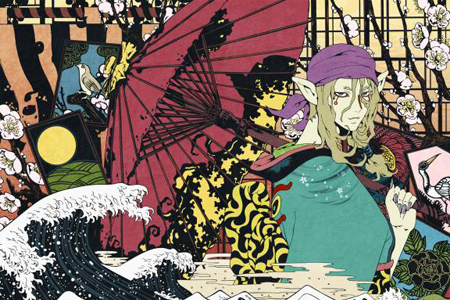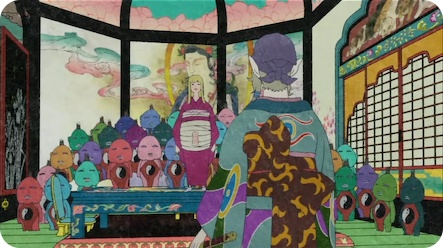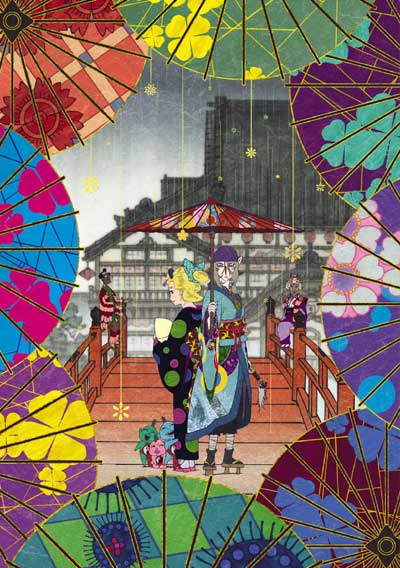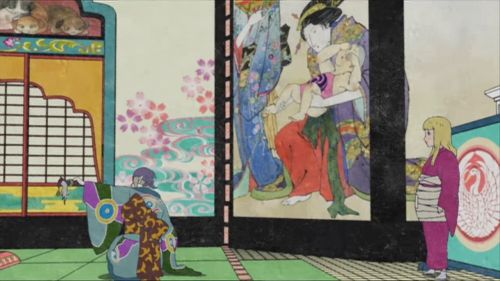Okay, I’m officially getting to work on the next book “Small Shen” (with Kylie Chan) in November, but I’ll hopefully be doing some work before October (where I head off to NYCC). I’ll talk more about that in a week’s time.
This week I recommend Mononoke. No, not Studio Ghibli’s Mononoke Hime. As worthy as that is of a recommendation, this is a completely different story, and a 12-episode TV series rather than a single movie. This series is obscure but highly underrated, and while it shares half of the more famous movie’s title, it’s simply titled Mononoke, nothing more.
 Mononoke (2007 – Toei Animation)
Mononoke (2007 – Toei Animation)
12 Episodes + 1 Short Story
Mononoke is an unusual TV series, not least because of its visual look. It began life as the third tale in a series of short Japanese horror stories, called Ayakashi. The first tale was famous Japanese horror tale Yotsuya Kaidan (Strange Tale of Yotsuya), the second was Tenshu Monogatari (Tale of the Goddess), and the last was Bakeneko (Monster Cat). Bakeneko was the one which introduced the enigmatic main character of Mononoke, a nameless, wandering medicine-seller who appears to do sidelines in exorcisms. Being the most interesting of the three tales, both due to its story and its art direction, audiences quickly demanded a new TV series based on the medicine-seller, and that was Mononoke.
Plot
“Mononoke” is a term for Japanese demons, and unlike conventional demons, the Mononoke in this series are often supernatural phenomenon created by people who died in unhappy circumstances, or who otherwise have grievances. The creatures take physical form, and is fully capable of doing real harm.
Enter the mysterious albino-elf character with face-paint and a snazzy fashion sense. This nameless, wandering merchant claims to sell medicine, but it’s really a cover for exorcisms he performs on the Mononoke he encounters in each episode. Despite having an impressive demon-busting form and an exorcism sword, the power of the medicine-seller is very limited. Since Mononoke usually have some kind of human origin (often psychological), it’s impossible to exorcise them until you discover the source of the phenomenon, and the reasons for their manifestation. For the medicine-seller, this involves finding the Katachi (shape), the Makoto (truth), and the Kotowari (reason) of the Mononoke.
Unlike conventional demon-busting shows (which tend to be action-oriented), this show is like a detective story with psychological puzzles at its core, all viewed through a Japanese supernatural lens.
Why I Recommend this Story
Mononoke is a gem. In both writing and art direction. Even if you’ve only seen a few screen caps of the series, you will probably already notice the bold, experimental style. The series looks like someone crossed traditional Japanese art with psychedelic art, adding a dash of Art Nouveau, Gustav Klimt, and surrealism along the way. I probably haven’t listed the wide range of art styles that this series sampled from, to create its unique look. Either way, it was a dream to look at, and its difference to the “conventional” anime look should be celebrated. For once, the experiment not only didn’t fail, but was a dramatic success.
All the more reason to marvel at the way this artistic style came to be. From what I can tell, the original series Ayakashi was a low-budget thing, and no one really had high expectations of Bakeneko, especially since top-billing went to Yotsuya Kaidan (famed illustrator Yoshitaka Amano was working on the character designs for that). I’m guessing the animators on Bakeneko thought, whatever, we can try something new with this since no one cares. Instead, Yotsuya Kaidan was a dull disappointment, and none of the lovely character designs by Amano translated well into anime. Conversely, Bakeneko was the triumph, and it was way more interesting to watch and look at than the other two stories.
The stories were also complex and engaging. You won’t expect a demon-busting story to be so cerebral and psychological, but these are – and many are also intensely internal. In every episode, there’s a number of other characters involved apart from the medicine-seller, and discovering their labyrinth psychological turmoil is part of the series – and the medicine-seller’s – job. Mind you, this is a horror series after all, and some of the stories get pretty grotesque in plumbing the depths of the human condition. The art can sometimes reflect the ugliness of the situation, but it’s never exploitative or truly disgusting. The writing also has a literary quality to it – by that, I mean it seems free of a lot of cliches and archetypes that an industry (in this case, the anime industry) often builds up over time. Like Kurosagi Corpse Delivery Service, I wonder if the writer comes from outside the anime/manga industry (in my mind, that is always a plus).
Perhaps the one “criticism” I have of Mononoke is the story-telling. It’s opaque, a tad jerky, filled with strange camera angles and is often straight-up trippy. But then, given the art-style and the subject matter, I shouldn’t have expected any other kind of story-telling that would have worked with the stories and the art. Mononoke is an unusual, strange take on a tired genre, and to use traditional methods of story-telling would have been a death-knell for the “feel” it was trying to evoke. It’s not, after all, a story for someone looking for something mainstream. No one I know had any trouble following the story, but its unapologetic weirdness will probably put off a lot of people who want something more… conventional. Average. Typical. If you want a more “normal” demon-busting story, stay the heck away from Mononoke – it’ll blow your mind in ways you’re not prepared for.
Lastly, the story is very, very heavily Japanese in origin, meaning that if you’re not familiar with some aspects of Edo-era Japanese culture, you may miss out on a few things. You don’t need much to understand the series, but someone with background knowledge will get more out of it. The story also ends at 12 episodes, which is a crying shame. In some ways I’m grateful that no one wants to run the series into the ground to milk more money, but I also wish more industry people will take notice of its artistic triumphs and act accordingly.





I will try to read this one sometime this week, sounds interesting. Thank you for this recommendation Queenie 🙂
This is an anime series. 🙂
You get to watch it~!